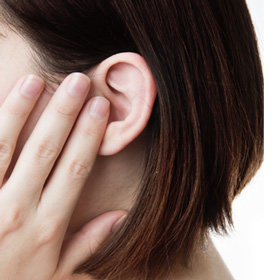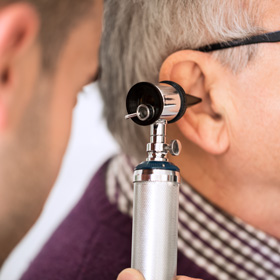People who live with tinnitus perceive sounds that have no genuine external source. Tinnitus manifests itself as buzzing, ringing, hissing, pulsating or other auditory sensations. It may affect one or both ears. The causes of tinnitus are numerous, but it often results from damage to the hearing apparatus, such as from exposure to extremely high noise levels. Tinnitus is also frequently accompanied by hypersensitivity to noise. Depending on its intensity and frequency, it can considerably impair the quality of life of people who suffer from it, including their ability to return to work. It can also cause physiological disorders similar to diseases linked to stress, anxiety, depression or auditory hypersensitivity.
Sylvie Hébert is a researcher at the brain, music and sound research laboratory of the Université de Montréal. “Tinnitus is quite a common, sometimes very debilitating, problem, and clinicians do not have clear protocols to assess it and to manage the care of those affected.” The goal of her team’s work is to improve the situation and to help these people by using current neuroscience theories on “central gain.” According to these theories, she says, “tinnitus and hyperacusis (hypersensitivity to noise) are caused by hyperactivity in the brain and the auditory pathways.”
To Better Understand
The auditory system is made up of two parts. The first part, the peripheral auditory system, is made up of the outer ear (the pinna and the ear canal), the middle ear (the eardrum and the ossicles), and the inner ear (cochlea) and the auditory nerve. The second part, the central auditory system, is made up of the auditory pathways of the brainstem, which make the connections to the brain and the cortex and the auditory cortex itself, i.e., the area of the brain linked to hearing.
The Theory of Central Auditory Gain
The “central auditory gain” model is a conceptual framework that is used to integrate and understand the adaptations observed in the auditory system. This model explains how the auditory system modulates its response when acoustic conditions change.
Studies have demonstrated that if subjects with normal hearing wear ear plugs, their hearing sensitivity increases. If, on the contrary, other subjects wear noise generators, their sensitivity to sound decreases. Trials conducted to date have been behavioural in nature and have reflected subjective perceptions and judgments. While these are interesting global measurements, they do not make it possible to localize the physiological site of the central gain. With respect to the measurement of stapedius reflexes (a reaction of the auditory system that stiffens the ossicles to protect itself from excessively loud noise), it reflects the contribution of the brainstem. However, this is only a small portion of the entire auditory system.

Tinnitus may manifest itself as buzzing, ringing, hissing, pulsating or other auditory sensations. It is frequently accompanied by hypersensitivity to noise.
Situating the Central Gain
The question regarding the very existence of the central auditory gain, and even more so, its location, remains unanswered. That is why the researchers decided, continues Sylvie Hébert, “to review all of the connections of the auditory system for which tests exist, from the cochlea to the brain, to determine where this hyperactivity comes from. Are we observing a gain, an increase in neural activity, and if so, where? That was the first part of our study, which focused on adult subjects with normal hearing.”
A Giant Step Forward
This exploration of the entire auditory system, from behaviour to the cortex, sets new milestones in the field. “Previously, in tests with human subjects, no laboratory had all it required to differentiate the responses in different parts of the auditory system. We are the first to do so—it is an extremely complex study,” comments the researcher. “Some of the methods used already existed in clinical settings; others were designed for the research, and still others were created by our laboratory.”
The Gain Manifests Itself in the Auditory Cortex
The study shows that the mechanism of gain adaptation occurs at the highest level of the auditory system, i.e., the cortex. In fact, no change was observed in the lower levels of the auditory pathways, i.e., the cochlea, the brainstem, and the auditory nerve responses. “We observed an increase in activity in the cortex after earplugs had been worn and a decrease after noise generators were worn. The modulation performed by the central gain was thus clearly observed in the auditory cortex. This is a major finding.”
Using the Gain for Rehabilitation
Previous work has suggested that a maladjusted central gain mechanism (in other words, one that is overactive) may be responsible for tinnitus and hyperacusis. According to that model, tinnitus results from spontaneous neuronal hyperactivity, while hyperacusis results from hyperactivity caused by external sounds. In short, the central auditory gain is chronically altered among people who present with tinnitus or hyperacusis.
Knowing that tinnitus is often accompanied by peripheral damage, such as to the cochlea, the researchers wanted to know whether it would be possible to reduce the central gain among affected individuals by having them wear noise generators. According to this hypothesis, a return to normal gain adaptation mechanisms would be shown by a decrease in sensitivity to external noise and the intensity of the perceived tinnitus.

In the long term, the researchers hope to implement an audiological assessment clinical protocol to diagnose, therapeutically direct and monitor workers with tinnitus.
Noise Generators
Basically, these are hearing aids, with the normal amplification functions for people with hearing loss. In the study, the amplification function was inactive, with the same noise being generated for all the participants, whether or not they had hearing loss. The participants wore noise generators for three weeks. Auditory and psychometric measurements were taken before the procedure, then after one, two and three weeks of wearing it, and finally, one month after the end of the subjects’ participation.
This study is the first to assess both internal perception of tinnitus through psychoacoustic evaluation and the auditory functions of known external sounds. “We precisely measured the entire frequency and intensity spectrum of tinnitus,” adds Sylvie Hébert. “This is very rare, and we have published several articles on the subject; it is a very reliable measurement.”
Towards a Solution
The laboratory results suggest that wearing noise generators reduces sensitivity to external sounds and reduces the sensation of tinnitus, especially in the group without hearing loss. The subjective intensity of tinnitus and the disturbance it causes also decreased with treatment. Are noise generators the solution to the problem of tinnitus? As Sylvie Hébert explains, “They won’t be a solution for everyone, and we’re not yet at the level of detail required to make recommendations, but the research will continue. For people with hearing loss, a possible option would be a combination of noise generation and amplification. But we didn’t test that in this study.”
Future Research
Great strides have been made and there is hope, because central gain modulation is a potentially powerful paradigm for rehabilitation. But many questions remain. For example, for people with hearing loss, the results were more mixed. Could they benefit more from the noise generator by activating the amplification function? Will the results be confirmed with greater numbers of subjects? What is the optimal duration of treatment? Can we observe a modulation of the central gain in the cortex of people with tinnitus? The researchers are already working on answers to these questions.
Author : Loraine Pichette